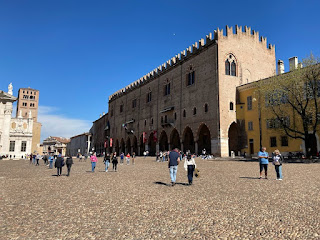Florentine maestro conquered hearts in Chicago
Internationally acclaimed operatic conductor Bruno Bartoletti, who conducted and served as an artistic director at Lyric Opera Chicago for more than 50 years, was born on this day in 1926 in Sesto Fiorentino in Tuscany.
Bruno Bartoletti spent more than 50 years at Lyric
Opera Chicago as conductor and artistic director
Bartoletti is recognised as having shaped the excellent reputation of Lyric Opera Chicago for staging great productions of Italian opera masterpieces, as well as modern works. He also directed Teatro dell’Opera di Roma and Maggio Musicale Fiorentino, and was principal conductor at the Danish Royal Opera.
His father, Umberto, was a blacksmith who played the clarinet in a band, and as a young boy Bruno Bartoletti played the piccolo. One of his teachers recognised his musical talent, and her husband, who was the sculptor Antonio Berti, recommended him to the Cherubini conservatory, where he studied the flute and the piano.
Bartoletti went on to play in the orchestra of the Maggio Musicale Fiorentino and then became a pianist on the staff of Teatro Comunale in Florence.
He assisted conductors such as Artur Rodzinski, Dimitri Mitropoulos, Vittorio Gui and Tullio Serafin, who was the one who encouraged Bartoletti to study conducting.
 |
| Bartoletti made his professional debut as a conductor in Florence in 1953 |
Bartoletti made his debut as a conductor in the United States in 1956 with Lyric Opera Chicago when he conducted Verdi’s Il trovatore, after Tullio Serafin had been taken ill. He had been recommended to the theatre by the Italian baritone, Tito Gobbi.
He subsequently became principal conductor of the Royal Danish Opera between 1957 and 1960.
From 1956 until 2007, Bartoletti conducted 600 performances of 55 different operas for Lyric Opera of Chicago. He became their principal conductor in 1964 and continued in that role until his retirement in 1999.
He also became co-artistic director at Lyric Opera and was later named sole artistic director. He worked with many famous opera singers, including Placido Domingo, Luciano Pavarotti and Renata Tebaldi.
His final appearance at Lyric Opera was in 2007 when he conducted Verdi’s La traviata.
 |
| Bartoletti died the day before his 87th birthday in 2013 |
Bartoletti was awarded the title of Cavaliere di Gran Croce della Repubblica Italiana by the Italian Government, and he was made a member of the Accademia di Santa Cecilia, one of the oldest and most prestigious musical institutions in the world. In his later years, he taught at the Accademia Chigiana in Siena. Bartoletti conducted his final opera, Manon Lescaut, in 2011.
With his wife, Rosanna, he had two daughters and five grandchildren. He died in Florence the day before his 87th birthday in 2013.
He has been acknowledged as a superb interpreter of 19th century and early 20th century Italian opera, but Bartoletti also embraced modern music and Slavic works, such as Bedrich Smetana’s Bartered Bride and Modest Mussorgsky’s Boris Godunov, during his career, although he is said to have rarely conducted symphonies.
Travel tip:
Sesto Fiorentino's historic Palazzo Pretorio was
built at the end of the 15th century
Bartoletti’s home town, Sesto Fiorentino, known locally as simply Sesto, is a town within the metropolitan area of Florence in Tuscany, situated about 12km (7.5 miles) to the northwest. With a population of around 49,000. It is famous above all for its tradition of ceramics. Once an ancient Etruscan settlement, it began to flourish at the time of ancient Romans, thanks to its position along the Via Cassia. Today, there are more than 100 pottery producers in Sesto Fiorentino, the first having been founded there in 1735 by Marquis Carlo Ginori. Now under the name Richard-Ginori, the company is still located in Sesto, which also hosts a state school for teaching pottery, L'Istituto Statale d'Arte. Notable buildings in Sesto Fiorentino include the beautiful Romanesque parish church of San Martino and the Palazzo Pretorio, built at the end of the 15th century as the seat of the podestà, the local representative of Florentine authority. The 15th century façade is still decorated with the coats of arms of the families who exercised power over the town between the 15th and 16th centuries.
Travel tip:
The new Teatro del Maggio Musicale Fiorentino
has been the home of the festival since 2014
The Maggio Musicale Fiorentino is an annual festival in Florence that has been held since 1933. It was started by Luigi Ridolfi Vay da Verrazzano, a politician and entrepreneur who also founded the AC Fiorentina football club, in conjunction with the conductor Vittorio Gui and another politician, Carlo Delcroix, who was its first president. It usually takes place from the end of April to the beginning of July and includes operas, concerts, ballets and prose performances. It has its origins in the ancient tradition of the musical festivals of May, called maggiolate. Originally, the festival was staged at the Teatro Comunale in Corso Italia, on the edge of the city’s historic centre, about 1.5km (1 mile) from the Ponte Vecchio along the Arno river. Since 2014, the festival has had its own base at the new Teatro del Maggio Musicale Fiorentino, situated less than a kilometre away on land opposite the public park known as Le Cascine. Designed by Paolo Desideri, it was inaugurated in 2011 with a performance of Beethoven's Ninth Symphony conducted by Zubin Mehta. The square in front of the theatre is named Piazza Vittorio Gui in honour of the festival’s founder.
Also on this day:
1465: The birth of statesman and political adviser Mercurino Arborio di Gattinara
1918: The death of opera composer and librettist Arrigo Boito
1940: Italy enters World War Two
1959: The birth of football manager Carlo Ancelotti



.jpg)






.jpg)







.png)






.jpg)






.jpg)

